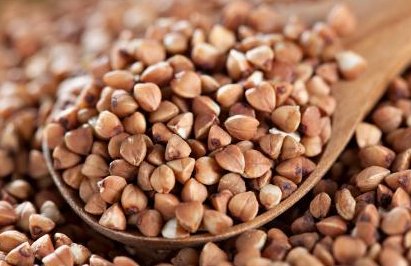Buckwheat

| Buckwheat in TCM:Explore the properties of Buckwheat according to Chinese
Nutrition and Traditional Chinese Medicine (TCM):
Temperature: cool
Channels: LI, SP, SI
Flavors: sweet
Special Properties:
circulates qi, clears heat, clears damp
In terms of Traditional Chinese Medicine (TCM) Buckwheat is known for its ability to circulate qi, descend the qi[22], clear heat, and resolve dampness.
In general the ancient Chinese medical texts cite that it enters the Spleen, Small Intestine, and Large Intestine. The flavor of Buckwheat is sweet, and it is considered to be cool in temperature. Although some sources list buckwheat as neutral in temperature [22], its actions match more closely with sources that consider it to be cool.
Buckwheat is known to clean and strengthen the intestines while also improving appetite. It has been used effectively to treat dysentery and chronic diarrhea. A bioflavinoid found in buckwheat (known as Rutin) can strengthen capillaries and blood vessels, inhibit hemorrhages, reduce blood pressure, and increase circulation of the hands and feet. "Rutin is also an antidote against x-rays and other forms of radiation (HWWF 462)."
Buckwheat can also be used externally for skin inflammations, eruptions, and burns- just apply a poultice made of roasted buckwheat flour mixed with vinegar.
Toasted buckwheat is known as "kasha". Kasha is one of the few alkalizing grains. Commercial kasha is thoroughly toasted and is dark reddish brown in color On the other hand raw buckwheat has an almost white color. By purchasing raw buckwheat one can choose to toast it less, or not at all, based upon the seasons.
Sproutable buckwheat seeds are excellent sources of chlorophyll, enzymes, and vitamins. Insects do not attack buckwheat and, like ginseng, buckwheat will usually die if grown with chemicals.
Buckwheat can help to resolve chronic diarrhea, dysentery, spontaneous sweating, skin lesions, and hypertension. For skin lesions boil buckwheat tea and was the affected area. For high blood pressure make tea from buckwheat and lotus root. For chronic leukorrhea and/or chronic diarrhea grind roasted buckwheat and mix with warm water. Take two tablespoons twice each day.[22]
Contraindications: Buckwheat is contra-indicated with heat signs such as high fever, thirst, red face, deep-red tongue color, and high blood pressure. Also contra-indicated for wind conditions like dizziness, disorientation, nervousness, spasms, or emotional instability.
Disclaimer: In accordance with our terms of service, by using this web site you agree that none of the information found on this web site constitutes medical advice. You should always consult your doctor before trying any particular food or herbal remedy to treat disease.
Folk remedies presented on this site are designed to address specifc TCM diagnoses, and are not one-size-fits-all. If you would like to learn more about Traditional Chinese Medicine (TCM) and how it relates to Chinese Nutrition, you can book in a free call with a licensed professional. There is no obligation to purchase.
[CLICK HERE for your free INITIAL CONSULTATION] |
